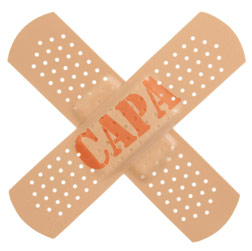How To Improve Your CAPA System
May 16th, 2013 // 12:32 am @ jmpickett
 Latest FDA and cGMP Compliance News
Latest FDA and cGMP Compliance News
FDA reports that more than 50% of the top FDA 483 citations and warning letter observations are always related to CAPA, or corrective and preventive actions. A strong CAPA system is set up to ID and correct faulty processes that cause a nonconformance, and will prevent such a nonconformance from occurring in the future.
FDA has put out several guidances about CAPA in the past, and the requirements for CAPAs may be found in 21 CFR 820.100. Basically, here is what you need to know:
- You should analyze your processes to determine what the root cause is of the nonconformity, and to ID probable causes of potential future nonconformities.
- Do an investigation of the cause.
- ID the actions that you need to correct and stop any nonconformance from happening again.
- Make sure that the CAPA is totally effective and is not going to cause any adverse events.
- Enact and record any changes in procedures to fix and prevent any recurrence of any noncompliance.
- Make direct releases of information on CAPAs to people who are responsible for making sure product quality is good enough and to make sure there is enough training to prevent such events in the future.
- Turn in any relevant documents on your CAPA system to management for review.
FDA has several guidelines that they will follow during a cGMP inspection to make sure that your CAPA systems are property set up and will correct and stop any nonconformance. It is very important that a system for CAPAs has the right processes to completely identify and investigate all root causes of problems. Also the system should be able to assign proper responsibility and to communicate the solution. It also should be able to keep a tracing system for all processes of CAPA, either paper or electronic.
Your CAPA process can be started by a customer complaint, a deviation in a process, a lab investigation, an audit, or even driven by employees. Once it is started, the central issue of the CAPA is to ID the root cause. One of the best ways to ID the root cause is to ask ‘why?’ at least three times and sometimes more. It always will be a waste of your time and money to fix a problem on the surface without determining what the root cause is.
Remember, it will always cost you less to stop a problem from happening than it is to fix it after it occurred.


